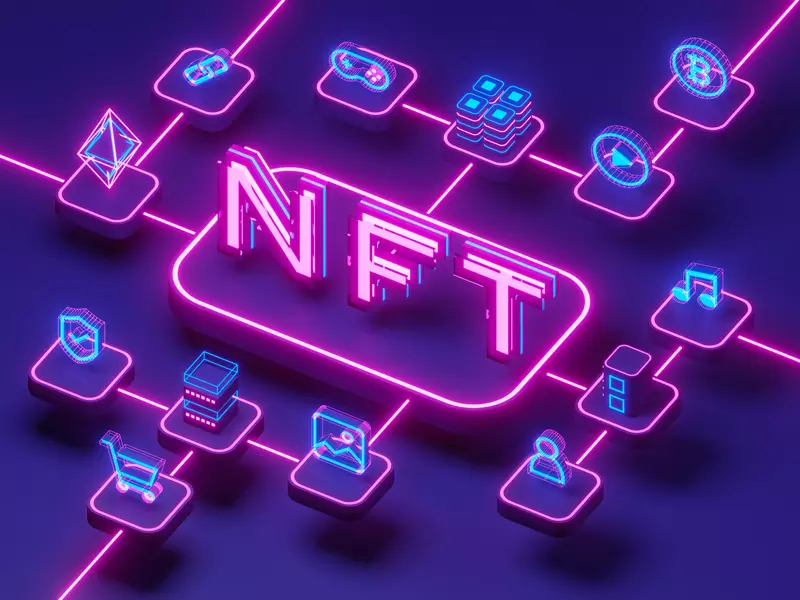The differences between fungible tokens and non-fungible tokens

Software, Application
The arrival of new applications on Ethereum has led to designing new kinds of token standards. In its early years, the ERC-20 token standard. However, in the past two years, NFTs have relied on a newer standard termed ERC-721. Lately, attention in the crypto market has been moving towards another standard — the ERC-1155 token standard. This debate of ERC-20 vs. ERC-721 vs. ERC-1155 can perplex teams, and it’s worth knowing when to employ each.
Fungible Tokens vs Non-Fungible Tokens
Many crypto assets that have been traded for a long time, such as Bitcoin and Ethereum, are fungible tokens.
Fungible tokens are like fiat currencies that are not unique and are interchangeable and divisible with another token of the same kind. The U.S. dollar is also a fungible token. For instance, 1 dollar is equivalent to another dollar. Fungible tokens are tokens that can be replaced, are unified, and can be divided into infinity. For instance, 1 bitcoin can be bought in small fractions such as 0.00000002 BTC.
Fungible tokens are very convenient to use, but things with actual value in real life are irreplaceable, such as a contract, house property rights, works of art, certificates, etc. Therefore, Non-Fungible tokens came into being.
Non-Fungible tokens contain identification information recorded in their smart contracts. This information makes each token unique and cannot be directly replaced by another token. They cannot be exchanged for one, because no two NFTs are the same. For example, there is only one Mona Lisa. In addition, Non-Fungible tokens are also inseparable, just like a part of a banknote cannot be given to others, a part of the banknote is not valuable and cannot be exchanged.
The unique properties of non-fungible make it usually linked to specific assets, which can be used to prove the ownership of digital items and even the ownership of physical assets.
What are ERC token standards?
What is ERC for Ethereum? ERC is an acronym for Ethereum Request for Comments. It looks like technical documents that define the methods, behaviors, and research applicable to a group of engineers and users who want to utilize the Ethereum ecosystem.
ERC token standards explain certain rules for all the ERC tokens built on the Ethereum blockchain. Ethereum’s community duly reviews this set of rules, making amendments based on the changing requirements. Also, ERC standards allow ERC tokens to interact seamlessly.
There are three ERC token standards: ERC-20, ERC-721, and ERC-1155. These standards appear as the three popular ERC token standards or protocols that have their applications across major industries. The Ethereum community fully approves these token standards, and they differ in terms of specific features and functionalities.
ERC-20 token standards
The ERC-20 protocol is an earlier and more popular token specification protocol on the Ethereum blockchain. ERC-20 was first proposed in 2015, and it was finally integrated into the Ethereum ecosystem in 2017. ERC-20 introduces the token standard for creating fungible tokens on the Ethereum blockchain. Simply put, ERC-20 consists of properties that support the development of identical tokens.
In practice, an ERC-20 token representing a currency can act like the native currency of Ethereum, Ether. That means 1 token will always be equal to the value of another token and can be interchangeable for each other. ERC 20 token set standards for the development of fungible tokens.
Each ERC-20 Token is strictly equivalent to the same value regardless of its feature and structure.
In simple words, ERC-20 is the token standard for fungible tokens such as cryptocurrencies, in-game character skills, or financial assets. ERC tokens’ most popular application areas are Stablecoins, governance tokens, and ICOs.
ERC-721: Non-fungible token standards
The ERC-721 token standard kicked off the NFT craze. This protocol is the first standard for NFT digital assets of non-fungible tokens in Ethereum, and it is applied to projects such as CryptoKitties and Decentraland.
The founder and CTO of Cryptokitties Dieter Shirley initially proposed developing a new token type to support NFTs. Compared with ERC-20, the ERC-721 protocol has more functions and more advanced technology. ERC-721 is invaluable for digital assets that represent someone’s ownership of those assets.
In simple words, ERC-721 is the standard that enables the trading of Non-fungible tokens (NFTs) such as digital artwork, unique media, in-game collectibles, and gaming characters on the blockchain. The most popular application areas of ERC-721 tokens are NFTs in digital art and gaming.
ERC-1155: Multi-token standards
ERC-1155 is very different from traditional tokens. Combining the abilities of ERC-20 and ERC-720, Witek Radomski (the Enjin’s CTO) introduced a multi-token standard for the Ethereum smart contracts. It’s a standard interface that supports the development of fungible, non-fungible tokens. The idea of such a unique token standard was to develop a robust smart contract interface that represents and manages different forms of ERC tokens.
ERC-1155 is a real game-changer because engineers can fulfill all their token development needs and address the problems using a single interface.
Also, ERC-1155 is that it improves the overall functionality of previous ERC token standards, making the Ethereum ecosystem more efficient and scalable.
ERC-1155 uses local Enjin coins to support these custom tokens, which can ensure that all assets created by this method have a guaranteed value, which can be obtained by using the local “melting” feature in the Enjin wallet to make tangible value.
In simple words, ERC-1155 is a smart contract interface that represents fungible and non-fungible tokens. It means ERC-1155 can perform the function of ERC-20 and ERC-720 and even both simultaneously.
ERC-1155 is applicable for creating NFTs, redeemable shopping vouchers, and so on.
What's next?
The motive of Ethereum unleashing new token standards is to cope with the evolving changeovers in the blockchain world. The Ethereum community rolled ERC-3475. It is the newest smart contract standard. Anyway, the three tokens ERC20, ERC721, and ERC1155 are currently highly efficient and inclusive in the digital ecosystem.
As you can see the digital world has become more complicated and many projects require competent engineers.
If you are looking for a wide range of Ethereum development services and solutions, such as smart contract development and blockchain solutions for various purposes, including crowdfunding, NFT marketplaces, crypto exchanges, and Apps Exotic Technology's team is happy to connect with you. Visit our site to learn more about Ethereum development services
https://www.exotic-tech.com/nft-landing-page.html




